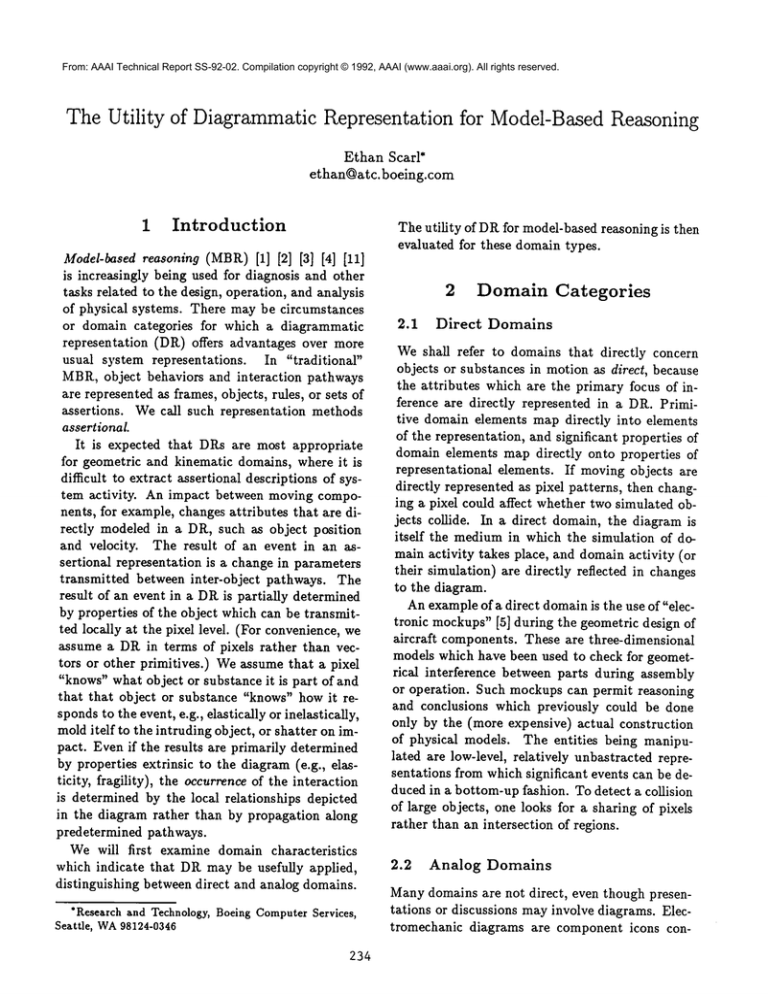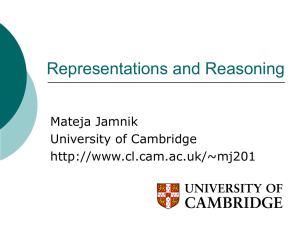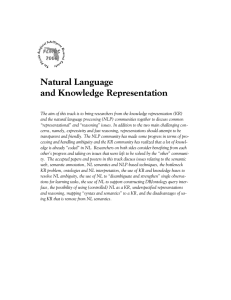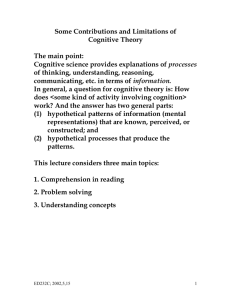
From: AAAI Technical Report SS-92-02. Compilation copyright © 1992, AAAI (www.aaai.org). All rights reserved.
The Utility
of Diagrammatic Representation
for Model-Based Reasoning
Ethan Scarf
ethan@atc, boeing.com
1
Introduction
The utility of DRfor model-based reasoning is then
evaluated for these domain types.
Model-based reasoning (MBR)[11 [21 [31 [41 [111
is increasingly being used for diagnosis and other
tasks related to the design, operation, and analysis
of physical systems. There may be circumstances
or domain categories for which a diagrammatic
representation (DR) offers advantages over more
usual system representations.
In "traditional"
MBR,object behaviors and interaction pathways
are represented as frames, objects, rules, or sets of
assertions. Wecall such representation methods
assertional.
It is expected that DRs are most appropriate
for geometric and kinematic domains, where it is
difficult to extract assertional descriptions of system activity.
An impact between moving components, for example, changes attributes that are directly modeled in a DR, such as object position
and velocity. The result of an event in an assertional representation is a change in parameters
transmitted between inter-object
pathways. The
result of an event in a DRis partially determined
by properties of the object which can be transmitted locally at the pixel level. (For convenience, we
assume a DRin terms of pixels rather than vectors or other primitives.) Weassume that a pixel
"knows"what object or substance it is part of and
that that object or substance "knows" how it respondsto the event, e.g., elastically or inelastically,
mold itelf to the intruding object, or shatter on impact. Even if the results are primarily determined
by properties extrinsic to the diagram (e.g., elasticity, fragility), the occurrence of the interaction
is determined by the local relationships depicted
in the diagram rather than by propagation along
predetermined pathways.
We will first examine domain characteristics
which indicate that DR may be usefully applied,
distinguishing between direct and analog domains.
"Research and Technology, Boeing Computer Services,
Seattle, WA98124-0346
234
2
2.1
Direct
Domain Categories
Domains
We shall refer to domains that directly concern
objects or substances in motion as direct, because
the attributes which are the primary focus of inference are directly represented in a DR. Primitive domain elements map directly into elements
of the representation, and significant properties of
domain elements map directly onto properties of
representational elements. If moving objects are
directly represented as pixel patterns, then changing a pixel could affect whether two simulated objects collide. In a direct domain, the diagram is
itself the mediumin which the simulation of domain activity takes place, and domain activity (or
their simulation) are directly reflected in changes
to the diagram.
Anexampleof a direct domainis the use of "electronic mockups"[5] during the geometric design of
aircraft components. These are three-dimensional
models which have been used to check for geometrical interference between parts during assembly
or operation. Such mockups can permit reasoning
and conclusions which previously could be done
only by the (more expensive) actual construction
of physical models. The entities being manipulated are low-level, relatively unbastracted representations from which significant events can be deduced in a bottom-up fashion. To detect a collision
of large objects, one looks for a sharing of pixels
rather than an intersection of regions.
2.2
Analog
Domains
Manydomains are not direct, even though presentations or discussions mayinvolve diagrams. Electromechanic diagrams are component icons con-
nected by wire symbols or other connectors. An
icon communicates the component’s type and the
identity of its terminals. The icons’ size, proportion, or placement are unimportant except to prevent confusion with other icons. These icons are
the alphabet for a graphical language, but not
themselves a subject of discourse. Wecall such
representations as analog (not to be confused with
"analog" indicating numeric parameters).
Useful reasoning can be done [I] [2] [3] [4] [ii]
with such representations,
but they are maps and
not the "mini-territories" of dlrect representations.
Topology of connections is the focus, not relationships among pixels. System activity in an
analog model is represented by parameters associated with the connectors, and by components’
constraints upon these parameters.
In an analog domain, the diagram is not the
medium in which simulation takes place. Activity in the domainis not reflected in changes in the
DR. Rather, the diagram directly represents static
and structural properties which do not change during normal operation.
2.3
Abstract
Domains
For completeness, other categories of diagram can
convey general activities or relationships without
supporting simulation. Such diagrams may have
aesthetic value or illustrate qualitative modesof
interaction. These will not be considered further
here.
3
Model-Based
Reasoning
In MBR,system models are composed of the system’s component models. Each significant
component is represented by one object in the model.
Componentbehaviors are usually explicit, as are
the paths by which they interact. Simulation and
hypothetical reasoning can be performed within
the same model. There are distinct advantages to
such models[2] [12], such as adapting to redesign or
failure, reasoning about alternate behaviors without predefining all variations or misbehaviors, and
accommodatingto sensor failure or missing data.
Such models will then support:
Simulation: Models can simulate the system by
propagating behaviors.
Monitoring: Comparing the simulation with the
the actual physical system, a deviation can indi235
cate a physical fault (diagnosis), a commandcorrection (control), or a change in the model (model
calibration, or system redesign).
Hypothesis Generation: The model may be directed to generate hypotheses representing possible
failures (diagnosis), commanded actions (control),
calibrations, or design changes.
Hypothesis Testing: The model is rerun with hypothetical behaviors or connections. This can verify a fault (diagnosis), a proposed command(control), the modelitself (model validation), or a modification (redesign).
3.1
MBR with
Analog
Models
Most (if not all) applications of MBRhave been
to analog models. These representations have already been abstracted to a convenient level for the
tasks of interest. It is often not easy to see howto
do otherwise. The behavior of an electric motor or
pumpis not present in a system diagram, even if it
includes moving fluid or rotating armatures. Additional laws could be specified like electromagnetic
induction, but the resulting computation ends up
the same as for the analog model. It is more appealing to visualize closing a valve as blocking fluid
motion instead of setting an admittance coefficient
to zero. This may be good for visual explanation,
but if the a quantitative simulation is needed then
the translation back to an underlying quantitative
model is inevitable. Even for qualitative simulation, the laws governing the system’s evolution in
response to stimuli are not in the diagram and must
be made explicit if the model is to follow them.
Diagrammatically propagating a value for electric
current along a schematic wire is inultive but not
particularly useful; the interesting behaviors occur
at junction points or within components, and not
along the connecting paths.
"Consistency-based" diagnostic reasoning [3]
[11] has become prevalent in MBR,and requires
that a system description is modified to be consistent with the set of observations. The system description is assumedto be a set of assertions, and
it is difficult to see howa DRcould be well-suited
for this.
3.2
MBR with
Direct
Models
Workhas been done using models [6] [10] [7] [8]
that represent complex geometric and kinematic
relationships, but much of this has been a search
for suitable abstractions from the geometry which
will permit a more-or-less traditional use of analog models. Workwith direct models [9] has been
virtually non-existent in MBP~.
Cana direct model fulfill the roles played by analog models for model-based reasoning? Simulation
is straightforward, since direct representations determines the relevant behavior of the target system by local propagation of attributes and events
within the image itself. Monitoring is plausible so
long as relevant properties of the representation are
accessible to the world as sensor data, and methods of world/model comparison are clear. The values of modeled properties are compared with those
observed, and discrepancies determine whether the
model is judged accurate.
Hypothesis generation is, as usual, more difficult. Giventhe state vectors of billiard balls leaving an elastic collision and someinitial conditions,
it may be possible to determine the point of contact after the fact. But it is easy to envision
only slightly more complexscenarios (e.g., inelastic collisions) wherein pushing observed data back
through interactions is either intractable or indeterminate. In general we speculate that hypothesis generation, while not impossible in all cases,
is likely to be even more difficult in direct than in
analog domains. It corresponds to time reversal,
which is feasible only for entropy-conserving processes. Once a hypothesis has been suggested, the
simulation can be rerun with it, and the results
tested against goals or observations, as for monitoring.
"Constraint relaxation" methods [13], which
propagate and test local constraints along explicit
pathways like line drawing edges, are often quite
visual, and it maybe possible to diagrammatically
represent the needed features. Thus, a pixel might
know that it is part of a convex edge and shadow
boundary to be resolved against properties of adjacent pixels. This sort of domainseems less natural
in an analog representation and no more fruitful.
Direct representations appear to be comparable
to analog for monitoring, simulation, and hypothesis checking, and maybe more difficult to use for
comparable hypothesis generation tasks. This indicates that diagrammatic representations are primarily useful when direct representations are easier or more natural to formulate and do inference
upon than analog ones.
There is another possibility to be explored, how236
ever: the simultaneous use of analog and direct
models of the same domain to extract the best features of each.
3.3
Hybrid
Analog/Direct
Models
It has been understood for some time [1] that multiple representations are needed for efficiency in
solving certain diagnostic problems, particularly
those caused by unexpected pathways of interaction. The discovery and elimination of candidates
for such faults requires a representation for reasoning about the plausibility of pathways. Using only
functional/behavioral knowledge to screen possible pathways is combinatorially unmanageable. A
commonexample is a "bridge fault," such as a
solder splash across the terminals of a integrated
circuit.
Another example (Abbott, AAAI88)
a rotor blade breaking off a jet engine’s turbine,
penetrating the engine casing, and severing a hydraulic control line in an aircraft’s wing. What
these examples have in commonare interactions
along pathways which did not exist in the nominal or "designed" system. Knowledge of these
pathways reduces multi-fault analysis to singlefault and avoids considerable complexity. Physical/geometric system descriptions are a reasonable
source of revised probabilities for such interactions.
Although a DR still contains no solder splashes
or flying rotor blades, it does provide proximity
metrics in which adjacent pins are more likely to
touch and in which a geometric surface of destruction implicitly emanates from any plane of high
centripetal force. Similar adjacencies include vibrational, thermal, radiative, or other normally
unconnected (or weakly connected) pathways.
all such cases, the DRappears more compact and
amenable to the needed inference methods (finding
closest conducting points, or collecting components
intersecting a given surface) than any corresponding assertional representation.
It appears that DtLs are generally more difficult to use for MBRthan comparable assertional
representations, especially for generating fault hypotheses, but they can come to the rescue in
certain particularly difficult hypothesis generation
tasks where assertional representations becomeunwieldy. This role for diagrammatic representations
is restricted but important at critical moments.
Assertional representations are used throughout
the diagnosis of "normal" faults, during which the
diagrammatic representation appears to have little
utility.
What makes "unexpected path" faults so
difficult is, in fact, not only that they are rare but
that they require distinct representations.
4
Summary
In understanding the utility of diagrammatic representations for model-based reasoning, and particularly for model-baseddiagnosis, it is helpful to
distinguish domains in which direct or analog representations are appropriate. Diagrammatic representations are naturally useful for direct domains,
while assertional representations are appropriate
for analog domains. However, there are circumscribed but important conditions in which DRs can
usefully supplement assertional representations for
determining unexpected interaction pathways.
References
[1] R. Davis, "Diagnostic Reasoning Based on
Structure and Behavior," in Qualitative Reasoning about Physical Systems, D. G. Bobrow
ed., MITPress, 1985, pp. 347-410.
[2] R. Davis, W. Hamscher, "Model-based Reasoning: Troubleshooting," in Exploring Artificial Intelligence: Survey Talks from the National Conferenceson Artificial Intelligence, H.
E. Shrobe, Ed., Morgan Kaufmann, San Mateo,
CA, 1988, pp. 297-346.
[3] J. de Kleer and B. C. Williams, "Diagnosing
Multiple Faults," Artificial Intelligence, 32 (1),
pp. 97-130, April, 1987.
[4] J. de Kleer, "Qualitative
and Quantitative
Knowledgein Classical Mechanics," Technical
Report TR-529, MIT AI Lab., 1979.
[5] M. A. Dornheim, "Computerized Design System Allows Boeing to Skip Building 777
Mockup," Aviation Week and Space Technology, pp. 50-51, June 3, 1991.
[6] K. D. Forbus, P. Nielsen, and B. Faltings,
"Qualitative
Mechanics: A Framework," in
Proceedings of the Tenth International Joint
Conference on Artificial Intelligence (IJCAI89), Milan, Italy, pp. 430-435, August, 1987.
237
[7]L.
Joskowitz, "Simplification
and Abstraction," in Proceedings of the Eleventh International Joint Conferenceon Artificial Intelligence (IJCAI-91), Detroit, MI, pp. 1337-1342,
August, 1989.
[8] L. Joskowitz, "Geometry, Motion, and ModelBased Reasoning," in Proceedings of the 1989
AAAI Workshop on Model Based Reasoning,
Detroit, MI, pp. 68-73, August, 1989.
[9] H. Narayanan, "Reasoning Visually about
Spatial Interactions,"
in Proceedings of the
Twelfth International Joint Conference on Artificial Intelligence (IJCAI-91), Sydney, Australia, pp. 360-365, August, 1991.
[10] P. Nielsen, "A Qualitative Approach to Mechanical Constraint,"n Proceedings of the Seventh National Conference on Artificial Intelligence (AAAI-88), St. Paul, MN,pp. 270-274,
August, 1988.
[11] Artificial
1987.
Intelligence, 32(1), pp. 57-95 April
[12] E. A. Scarl, "Monitoring and Diagnosis: Stress from Weakened Environmental
Knowledge," in Proceedings of IEEE International Conference on Robotics and Automation,
Sacramento, CA, April, 1991.
[13] D. Waltz, "Generating Semantic Descriptions
from Drawings of Scenes with Shadows," in
Psychology of Computer Vision, McGraw-Hill,
NewYork, 1971, pp. 19-92.




